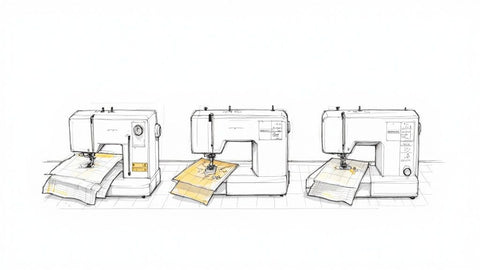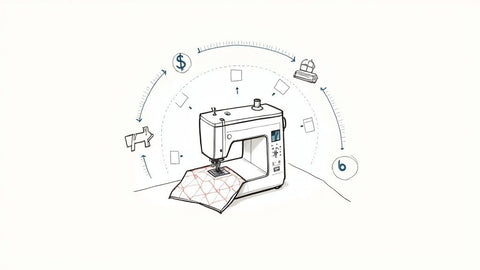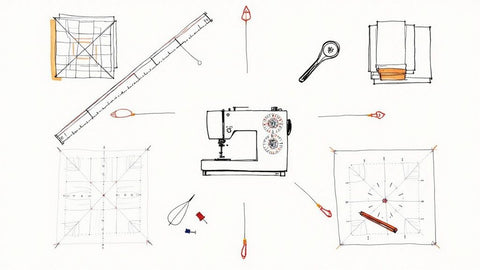Finding the best quilting machine for beginners isn't about getting the fanciest model on the shelf. It's about finding a creative partner that empowers you to create beautiful, tangible projects, from simple patchwork pillows to intricate wall hangings.
For most people just starting out, a solid computerized sewing machine or a tough-as-nails mechanical one is the sweet spot. The key is to find a machine that not only has the right features—like a generous throat space and a walking foot—but also comes with the support you need to actually use those features. This guide will show you what to look for and how those features translate into projects you can replicate at home.
Choosing Your First Quilting Machine
Taking the plunge into quilting is an exciting moment, and your first machine is a huge part of that. Think of it as your primary tool for turning fabric into art. The perfect beginner machine should feel intuitive, allowing you to unbox it and start creating a simple project like a nine-patch block almost immediately.
The best machines are designed to grow with you. They handle your first straight stitches with ease and are ready when you want to tackle your first free-motion quilting design on a custom table runner.
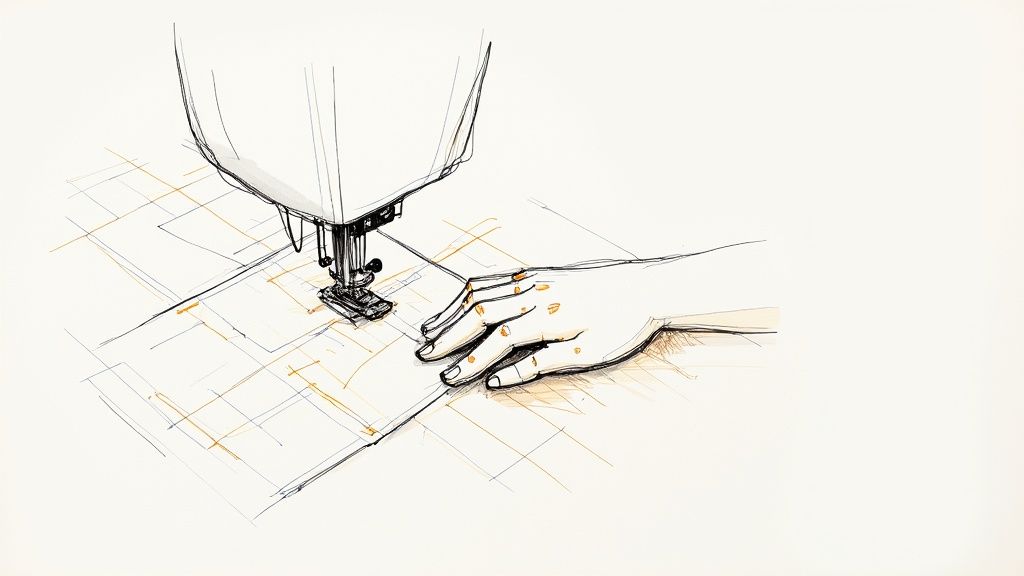
Here at bsewinn.com, we’re committed to empowering crafters. We don't just sell custom sewing machine designs; we provide a complete ecosystem to help you succeed. Our online classes, training videos, and extensive resources are designed to serve as "how-to" guides, showing you exactly how to create beautiful projects. When you choose bsewinn.com, you get more than a machine—you get a partner dedicated to helping you bring your creative visions to life.
Key Machine Types for New Quilters
The first big choice you'll face is between two main types of machines: mechanical and computerized. It helps to understand how each type supports the creation of different sewing machine designs.
Mechanical machines are the workhorses. With simple, manual dials, they are perfect for mastering the fundamentals. If you want to create a classic log cabin block, a mechanical machine gives you direct control over every stitch.
Computerized machines offer modern convenience. Features like push-button stitch selection and speed control make it easier to achieve precision. For a project like an appliquéd tote bag, a computerized machine allows you to slow the speed for perfect stitches around curves, a tangible advantage for a beginner.
To help you see the difference at a glance, this simple table breaks down the main types of machines suitable for new quilters.
Beginner Quilting Machine Types at a Glance
This summary should help you pinpoint which type of machine might be the best fit for the projects you want to create.
| Machine Type | Best For | Key Advantage | Typical Price Range |
|---|---|---|---|
| Mechanical | The crafter who values simplicity and wants to master foundational skills on projects like simple patchwork. | Often more affordable and easier to maintain. | $150 - $400 |
| Computerized | The quilter who wants to create precise designs and use a variety of stitches for appliqué or decorative quilting. | Convenience features that save time and improve accuracy. | $300 - $800 |
There's no single "right" answer. The best choice depends on the tangible examples of sewing machine designs you hope to replicate.
As you weigh your options, don't forget that the machine is just one piece of the puzzle! For broader advice on buying new craft supplies, these general tips for choosing craft tools are helpful, no matter the hobby.
What to Look For in a Good Quilting Machine
When you're shopping for your first quilting machine, it's easy to get distracted by flashy features. But the best machine for a beginner is one with the right tools to create tangible projects. These core functions will build your confidence and make quilting a joy.
Think of your machine as a creative partner in your next project. When a function like the needle up/down button helps you pivot perfectly on a star block point, you can focus on the craft, not the machine. At bsewinn.com, our custom machine designs and extensive resources are built to help you master these essentials. Our online classes provide "how-to" guides for creating specific designs, showcasing how each machine feature is used in a real project you can follow along with.
Throat Space: A Quilter's Best Friend
If there's one feature quilters talk about, it's throat space—the distance between the needle and the body of the machine. Your standard sewing machine might only have 5-6 inches. For quilting a lap blanket, you'll want at least 8 inches or more.
That extra room is a game-changer. When quilting your first baby quilt, it prevents the fabric from bunching, leading to smoother stitches and less frustration. It's a tangible feature that directly impacts your ability to replicate larger designs successfully.
Key Mechanical Features You'll Actually Use
A few key features can make or break your first quilting projects. A solid metal frame handles vibrations better, meaning fewer skipped stitches when you're quilting a sturdy tote bag with multiple layers.
Here are a few other non-negotiables I recommend for any new quilter:
- Walking Foot Compatibility: This is the most important accessory for quilting. When you’re quilting straight lines on a placemat set, the walking foot grips all three layers evenly, preventing puckering. It’s the secret to professional-looking results.
- Needle Up/Down Function: This button lets you choose whether the needle stops in or out of the fabric. When piecing a block with sharp points, stopping with the needle down pins your quilt in place so you can pivot perfectly without losing your stitch line.
- Adjustable Speed Control: A speed control slider lets you set a comfortable maximum speed. When you're trying free-motion quilting for the first time on a practice sandwich, you can set the speed to slow, giving you the control to create smooth, even curves.
You'll know you have a true quilting machine when it combines a generous throat space with a reliable walking foot and precise speed control. This setup provides the support a beginner needs to successfully create their first quilting projects.
It's a great time to be a quilter! The global quilting machine market was valued at around $850 million in 2023 and is expected to keep growing. This means more user-friendly models designed to help you succeed.
These core features are available on both machine types. For a deeper dive, check out our guide comparing computerized vs. mechanical sewing machines. Once you have the right machine, bsewinn.com's extensive resources, including online classes and training, provide the "how-to" support you need to tackle any custom design.
Comparing Top Beginner Quilting Machines
Picking the best quilting machine for beginners requires thinking about how its features will help you create specific designs. The perfect machine for someone making simple nine-patch pillows might not be the right fit for another person who wants to replicate a free-motion quilted wall hanging.
This is where a side-by-side comparison helps. We'll look at how different machines handle the quilting tasks you'll be doing. Our focus is on the real-world, hands-on experience, drawing from bsewinn.com's commitment to empowering crafters with the tools and knowledge they need to create.
Mechanical Simplicity vs. Computerized Convenience
Let's consider a tangible project: creating a set of quilted coasters. With a mechanical machine, you'll turn manual dials to select a straight stitch. This direct control is excellent for mastering the basics of piecing and achieving a perfect quarter-inch seam.
Now, imagine making those same coasters with a computerized machine. You could use a decorative stitch to quilt them, selected with the push of a button. You could also set the speed control to slow for precise topstitching around the edges. The machine's features directly support a more complex design choice, even for a beginner.
This image gives a quick snapshot of how three popular beginner models might compare on price, speed, and weight.
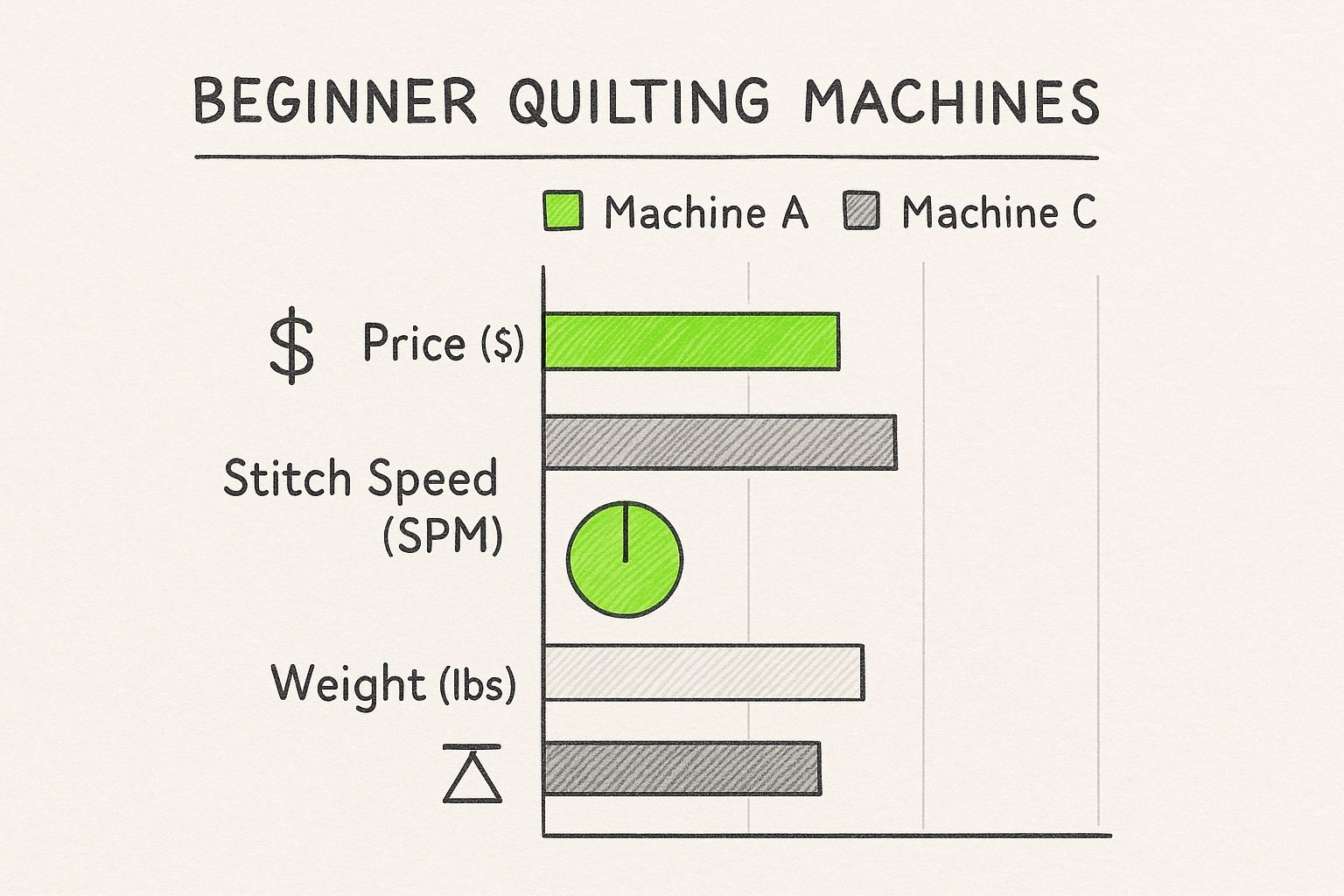
You can see the trade-offs pretty clearly. A lower-priced machine might be lighter but slower, while a faster machine often costs more and has some heft to it.
Before we dive deeper, let's look at some key features side-by-side. This table breaks down what you can expect from three archetypal beginner machines, helping you see where the real differences lie.
Feature Comparison of Beginner Quilting Machines
This detailed breakdown focuses on features that directly impact a new quilter's ability to create various projects.
| Feature | Model A (Mechanical Focus) | Model B (Computerized Value) | Model C (Hybrid Quilter) |
|---|---|---|---|
| Control Type | Manual dials | Push-button with LCD screen | Push-button, larger LCD, some dials |
| Speed Control | Foot pedal only | Yes, with a slider | Yes, advanced slider control |
| Stitch Selection | 15-25 basic & stretch stitches | 50-100 stitches, including deco | 100+ stitches, plus alphabet |
| Throat Space | 5.5" - 6.5" | 6.5" - 7.5" | 7.5" - 8.5" |
| Needle Up/Down | No | Yes, programmable | Yes, programmable |
| Included Feet | Basic presser feet | Adds 1/4" foot, walking foot | Adds quilting & free-motion feet |
| Extension Table | Not included | Sometimes included | Usually included |
| Ideal For | Learning basics on coasters & potholders | Piecing baby quilts, simple free-motion | Creating larger quilts & complex designs |
This table shows that as you move up in models, you gain features that empower you to replicate more ambitious and precise quilting designs.
Real-World Performance Scenarios
Let's imagine you're following a bsewinn.com "how-to" guide to make a simple baby blanket with straight-line quilting. On a sturdy mechanical machine, you’ll pop on a walking foot and rely on your own steady pressure on the foot pedal. It's a fantastic way to build foundational skills.
Now, picture making the same blanket with its computerized cousin. You'd still use the walking foot, but you could set the speed control to a comfortable crawl and engage the needle-down function. Every time you stop to pivot, the needle stays in the fabric, giving you a perfectly sharp turn. This makes it easier to replicate the crisp, professional look shown in the guide.
What if you're piecing a tricky star block from a pattern? A well-made mechanical machine provides a beautiful, consistent straight stitch. But a computerized model might have a dedicated patchwork stitch that locks at the beginning and end, helping you create a more durable and precise block, just like the example.
The key differentiator is how a machine's features empower you to create tangible designs. If you want to master the basics through simple projects, a mechanical machine is a great teacher. If you want the machine to help you replicate more complex designs with precision, a computerized model is a powerful creative partner.
Evaluating Motor Strength and Included Accessories
Quilting means sewing through at least three layers. A machine with a weak motor might struggle when quilting a denim patchwork pillow. A powerful motor, common in quilting models, will punch through those thick layers without skipping a beat.
Finally, look at the included accessories. A machine that includes a walking foot, a free-motion foot, and an extension table is an incredible deal, giving you the tools to attempt a wide range of designs right away. At bsewinn.com, our custom machine packages and training resources are designed as comprehensive "how-to" guides, showing you exactly how to use these essential accessories to create stunning projects from day one.
Your First Projects on a New Quilting Machine
A new machine's true worth is measured by the beautiful things you create with it. Let’s explore how the right beginner machine empowers you to replicate tangible quilting projects, turning your creative ideas into reality.
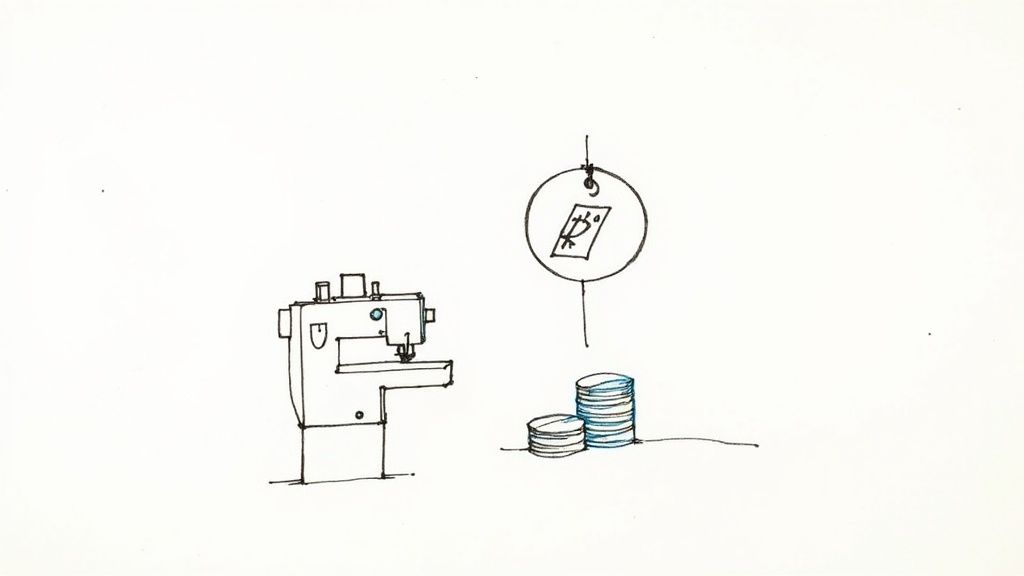
Picture this tangible example: you start with a classic nine-patch block to create a simple potholder. This is the perfect first project for mastering a precise quarter-inch seam. A model with a clear 1/4" presser foot makes it easy to replicate the neat, aligned squares you see in tutorials, building your confidence with every stitch.
Next, you can assemble several blocks into a small baby blanket. This is where a machine with a walking foot proves its value. As you quilt straight lines across the blanket, the walking foot ensures all three layers feed through evenly. This tangible support helps you avoid the frustrating puckers common for beginners and allows you to create a beautiful, handmade gift you can be proud of.
Building Your Skills with Guided Support
Tackling these first projects is easier with a guide. Here at bsewinn.com, our commitment is to empower crafters. Our custom sewing machine packages are supported by online classes and video tutorials that serve as comprehensive "how-to" guides. We walk you through creating tangible examples, from a simple coaster to a full-sized quilt, breaking down everything from machine setup to the final stitch.
For a deeper dive into getting started, our guide on the 4 easy steps to start quilting is the perfect companion to our hands-on training resources.
It's an amazing time to get into this craft. The U.S. quilting industry hit $4.5 billion in 2025, a massive jump from $1.8 billion back in 2000. This growth is all thanks to new hobbyists starting their journey with a beginner-friendly quilting machine, just like the ones we've been talking about.
Venturing into Free-Motion Quilting
Once you're comfortable, you can try free-motion quilting on a small project, like a custom pillow cover. This is where features like an adjustable speed control and a needle up/down function become essential tools for creation.
You’ll swap for a free-motion foot and drop the feed dogs. The speed control slider lets you find a slow, steady pace, making it easier to "draw" a simple looping or stippling design. The needle-down function holds your project in place every time you pause, helping you replicate the smooth curves shown in a video tutorial.
For a beginner, a machine's true value is how it helps you successfully replicate projects. The right machine, paired with bsewinn.com's extensive resources and "how-to" guides, makes the journey from novice to confident quilter feel achievable and fun.
These projects are the foundation of your quilting journey. With a machine that supports you and the extensive resources from bsewinn.com, you’re not just buying a tool—you’re gaining a partner committed to your creative growth.
Alright, you've seen the specs, you've weighed the features, and now it’s time to land this plane. Choosing your first quilting machine is a huge deal—it’s personal, and the “right” machine is the one that fits you and the quilts you’re dreaming of making.
Let’s get down to it. Ask yourself what you see when you picture your future quilts. Are you imagining classic, cozy patchwork quilts with satisfyingly straight seams? Or are you itching to try swirly, free-motion designs that look like art? Your answer is the key that unlocks whether a solid mechanical machine or a more feature-rich computerized model is your perfect match.
Which Quilter Are You?
To cut through the noise, let’s see if you recognize yourself in one of these common quilting personalities. Finding your tribe here can really zero in on the perfect machine for your style and budget.
- The Budget-Conscious Hobbyist: You want to dive into quilting without diving deep into your savings. You need a reliable workhorse for piecing and simple quilting that just works. A sturdy, no-fuss mechanical model is your best friend—it'll help you nail the fundamentals without overwhelming you.
- The Aspiring Artisan: You're excited about quilting and can already see yourself wanting to try more advanced techniques down the road. An entry-level computerized machine is your sweet spot. Features like speed control and a needle up/down function will feel like magic as you grow from basic piecing to adventurous free-motion quilting.
- The Crafter Who Values Simplicity: All the buttons and screens feel like a bit much. You just want to sit down and sew without a steep learning curve. The best machine for you is one with a powerful motor and a beautiful straight stitch. Forget the bells and whistles; you want pure, simple quality.
No matter which path you take, the real goal is to find a machine that feels like a natural extension of your hands. The best choice isn't the one with the most features; it's the one that makes you genuinely excited to start quilting and doesn't get in the way of your creativity.
You've Got a Partner in This
Making this decision feels big, I know. But you’re not in it alone. This is exactly why the support network at bsewinn.com is such a game-changer. We are committed to empowering crafters through our custom machine designs and the extensive support we offer. Our huge library of online classes, training resources, and expert support are designed to be comprehensive "how-to" guides, showing you tangible examples of sewing machine designs you can replicate. You'll feel confident from the moment you unbox your new machine.
The quilting world is absolutely booming. The global quilt market hit a massive $5.32 billion in 2024 and is only expected to keep growing. That growth is pushing manufacturers to create more innovative and user-friendly machines than ever before. You can learn more about the future of the quilting market and its trends to see just how exciting this space is. It’s a fantastic time to be a new quilter!
When you choose a bsewinn.com machine, you’re not just buying a piece of equipment. You're gaining a partner who’s just as invested in your quilting journey as you are.
Got Questions? Let's Talk Quilting Machines
Diving into the world of quilting machines can feel a little overwhelming, and it's totally normal to have a few questions swirling around. I've been there! Let's clear up some of the most common things beginners ask so you can feel 100% confident in your choice. This is the last step before you find the perfect partner for your creative journey.
Can I Just Use My Regular Sewing Machine for Quilting?
The short answer? Yes, you absolutely can. Lots of us started out quilting on a standard sewing machine. But—and this is a big but—the best quilting machine for beginners will have a few key features that make the whole process worlds easier and way more fun.
Dedicated quilting machines are built with the quilter in mind. They usually have a much wider "throat space" (the area to the right of the needle) so you're not wrestling with a bulky quilt. They also pack a stronger motor to punch through all those layers without complaining and have handy functions like a needle up/down button. At bsewinn.com, our commitment is to empower crafters, which is why even our beginner-friendly custom designs include these essentials, so you can successfully create projects from day one.
What’s the Single Most Important Accessory I Need to Start Quilting?
If I had to pick just one, it would be the walking foot. No question. This foot is a game-changer. It has its own set of feed dogs on top that work with the ones on your machine, grabbing the top layer of fabric and moving it along at the same pace as the bottom layer. This is your secret weapon against puckering and shifting, the two things that can really ruin a project you've poured your heart into.
Your next must-have, especially if you get the itch to try free-motion quilting, is a darning or free-motion foot. This little guy lets you move the fabric in any direction you want, so you're basically drawing with thread. It’s so much fun!
Our online classes and training resources at bsewinn.com are filled with "how-to" guides and tangible examples showing you exactly how to use these feet to create beautiful designs.
Should I Get a Mechanical or a Computerized Machine?
This is such a personal choice, and there’s no wrong answer. It really comes down to the types of sewing machine designs you want to create and how you feel about technology.
Mechanical machines are workhorses. They're known for being incredibly durable with straightforward manual dials. If you want to create a classic log cabin quilt and master the fundamentals, a mechanical model is a fantastic teacher.
On the other hand, computerized machines are about precision and convenience. If your goal is to replicate a complex appliqué design from one of our guides, features like speed control and a wide variety of built-in stitches will be invaluable. The experts over at bsewinn.com are great at helping you talk through your creative goals to find the right fit.
Ready to find a machine that will grow with you on your quilting adventure? At bsewinn.com, we are committed to empowering crafters with our custom sewing machine designs and the extensive support offered via online classes, training, and resources. Let's find the perfect machine to bring your creative vision to life today at https://www.bsewinn.com.

